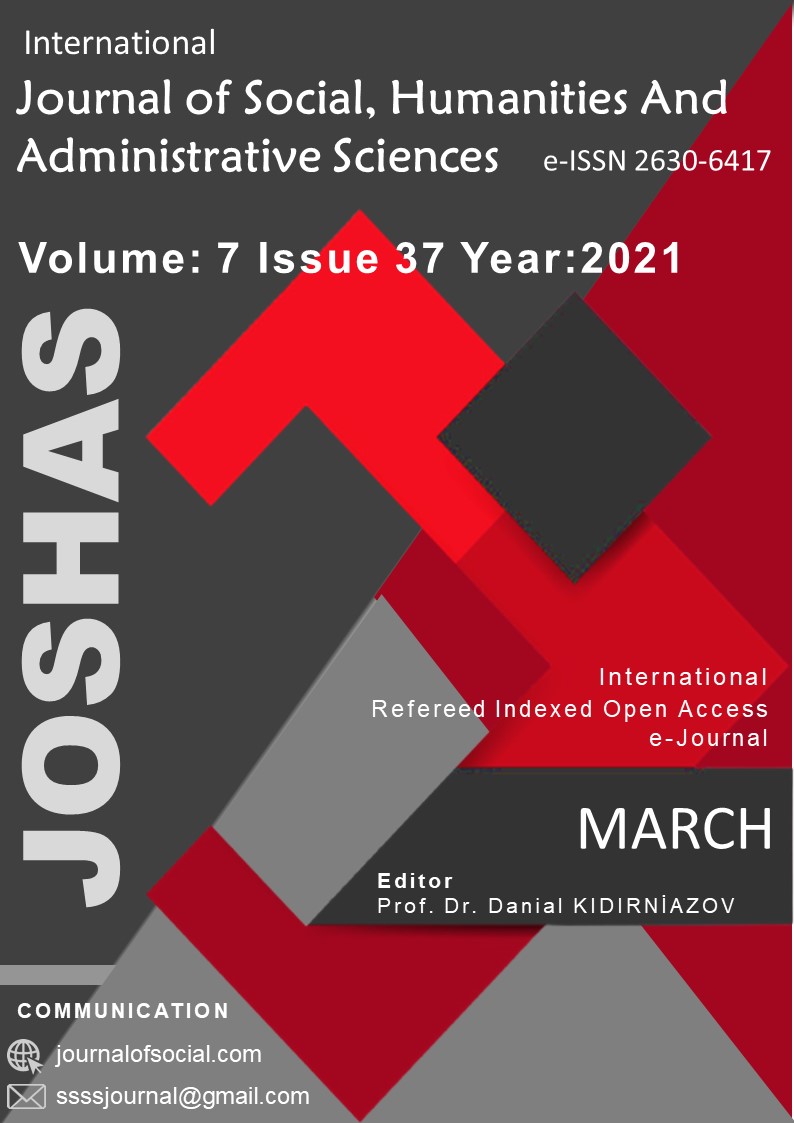LOJİSTİK PERFORMANS ENDEKSİ VE GSYİH - TÜRKİYE'NİN LOJİSTİK PERFORMANSI VE KOMŞU ÜLKELERİNİN LOJİSTİK PERFORMANSI ARASINDAKİ İLİŞKİ
Author :
Abstract
Ticarette giderek artan rekabet ortamı, lojistik performansın iyileştirilmesini zorunlu kılmaktadır. Lojistik sektörü, lojistik performansının iyileştirilmesi uygun altyapı koşullarının sağlanmasına bağlı olması nedeniyle gelişmiş ekonomilerin en önemli unsurlarından biri olarak kabul edilmektedir. Bu bağlamda lojistik sektörü, ticarette rekabet avantajı sağladığı için sosyal ve ekonomik kalkınmada önemli bir role sahiptir. Literatürde birçok çalışma lojistik sektörü ile bir ülkenin refah düzeyi arasındaki ilişkiyi araştırmıştır. Bu çalışmada, Türkiye ve komşu ülkelerinin lojistik performansı ve kişi başı GSYİH puanı regresyon analizi ile karşılaştırılmıştır. Bu amaçla Dünya Bankası tarafından yayınlanan 2007, 2010, 2012, 2014, 2016, 2018 verilerine ait Lojistik Performans Endeksi (LPI) ve kişi başı GSYİH analiz edilmiştir. Türkiye ve komşularının LPI skorlarının arasındaki ilişkinin incelenmesi de bu çalışmanın amaçlarındandır. Yapılan analiz sonucunda Türkiye ve komşu ülkeler için LPI skoru ve kişi başı GSYİH puanları arasında anlamlı bir korelasyon bulunmaktadır. Türkiye'nin LPI skoru ile komşu ülkelerin LPI skorları arasında anlamlı bir ilişki bulunamamıştır.
Keywords
Abstract
The increasingly competitive environment in trade has made it necessary to improve logistics performance. Logistics sector is considered as one of the most important elements of developed economies since improving logistics performance depends on providing suitable infrastructure conditions. In this context, the logistics sector has an important role in social and economic development due to its benefit in providing a competitive advantage in trade. Many studies in the literature have researched the relationship between the logistics industry and the welfare of a country. In this study, Turkey and its neighbor's logistics performance and GDP per capita score are analyzed by regression analysis. For this purpose, Logistics Performance Index (LPI) and GDP per capita in belonging to 2007, 2010, 2012, 2014, 2016, 2018 data as published by the World Bank have been analyzed. Analyzing the relationship LPI scores of Turkey and its neighbors is also the objective of this study. As a result of the analysis made, there is a significant correlation between the scores of LPI and GDP per capita for Turkey and its neighboring countries. There is no significant relationship between Turkey's LPI scores and its neighboring countries' LPI scores.
Keywords
- Arvis, J. F., Mustra, M. A., Panzer, J., Ojala, L., & Naula, T. (2007). Connecting to compete: Trade logistics in the global economy. World Bank: https://lpi.worldbank.org/
- Arvis, J.-F., Mustra, M. A., Ojala, L., Shepherd, B., & Saslavsky, D. (2010). Connecting to Compete: TradeLogistics in the Global Economy - The Logistics Performance Index and Its Indicators, World Bank Report: Retrieved from https://openknowledge.worldbank.org/
- Banister, D., Berechman, Y. (2001) Transport Investment and Promotion of Economic Growth, Journal of Transport Geography, 9(3):209-218.
- Bizoi, A., Sipos, C. (2014). Logistics Performance and Economic Development – A Comparison wihin theEuropean Union, Multıdıscıplınary Academıc Conference On Economıcs, Management And Marketıng In Prague, Mac-Emm Volume: Proceedings Of Mac-Emm 2014, Prague, Czech Republic
- Bîzoi, C., Popescu, A., Sipos, G., Sipos, C. (2015). The Transportation And Logistics Sector's PerformanceAnd The Social Development-A Comparison Within The European Union, Studia Universitatis Babes-Bolyai, 60:68
- Bottasso, A., Conti, M., Ferrari, C., Tei, A. (2014). Ports and Regional Development: A Spatial Analysis on a Panel of European Regions, Transportation Research Part A: Policy and Practice, 65:44-55.
- Bugarčıć, D.Z., Skvarciany, V., Stanıšıć, N. (2020) Logıstıcs Performance Index In Internatıonal Trade: CaseOf Central And Eastern European And Western Balkans Countrıes, Verslas: Teorija ir praktika / Business: Theory and Practice, 21:452-459.
- Chamber of Shipping, Journal of Chamber of Shipping (2017), Retrieved from: https://www.denizticaretodasi.org.tr/tr/yayinlarimiz/dergi
- Çelebi, D. B. (2010). Analytical Network Process For Logistics Management: A Case Study in A Small Electronic Appliances Manufacturer, Computers & Industrial Engineering, 58: 432-441.
- D’Aleo, V. (2015). The Mediator Role of Logistics Performance Index: A Comparative Study, Journal of International Trade, Logistics and Law, 1:1-7.
- Gani, A. (2017). The Logistics Performance Effect in International Trade, The Asian Journal of Shipping and Logistics, 33(4):279–288.
- Gunasekaran, A. N. (2003). The Successful Management of A Small Logistics Company, International Journal of Physical Distribution & Logistics Management, 33(9):825-842.
- Gunasekera, K., Anderson, W., & Lakshmanan, T. R. (2008). Highway-induced Development: Evidence from Sri Lanka. World Development, 36(11):2371-2389.
- Hong, J. (2007). Transport and The Location of Foreign Logistics Firms: The Chinese Experience. Transportation Research Part A: Policy and Practice, 41(6):597-609.
- Jhawar, A, Garg, S.K. & Khera, S. N. (2014). Analysis of Skilled Work Force Affect on the Logistics Performance Index - Case Study from India, Logistics Research, 7: 117.
- Kabadurmuş, F.N.K. (2019). The Relationship Between Logistics Performance and Innovation: An EmpiricalStudy of Turkish Firms, The Journal of Operations Research, Statistics, Econometrics and Management Information Systems, 7:158-172.
- Krugman, P. (1991). Increasing Returns and Economic Geography. Journal of Political Economy, 99(3): 483- 499.
- Lean, H. H., Huang, W., & Hong, J. (2014). Logistics and economic development: Experience from China. Transport Policy, 32:96-104.
- Loebbecke, C., Philip, P. (1998). Competitive Advantage from IT in Logistics: The Integrated Transport Tracking System", International Journal of Information Management, 18(1):17-27.
- MFA, Ministry of Foreign Affairs, http://www.mfa.gov.tr/turkey_s-multilateral-transportation-policy.en.mfaMinistry of Development, (2013), 10. Development Plan 2014-2018, Retrieved from: https://www.ahika.gov.tr/assets/upload/dosyalar/onuncu-kalkinma-plani.pdf
- Shang, K. & Marlow, P. B. (2005). Logistics Capability and Performance in Taiwan's Major Manufacturing Firms, Transportation Research Part E: Logistics and Transportation Review, 41(3):217-234.
- Shang, K., Marlow, P.B. (2007). Logistics Capability and Performance in Taiwan’s Major Manufacturing firms., Transp Rep Part, 217-234.
- Sharapiyeva, M.D., Antoni, A., Yessenzhigitova, Raikul, (2019). The Impact of Port Transport-logisticsInfrastructure and LPI for Economic Growth: on the Example of Landlocked Countries, Pmorstvo, 33(1):63- 75.
- Torre, A. (2008). On The Role Played by Temporary Geographical Proximity in Knowledge Transmission, Regional Studies, 42(6):869-889.
- Uca, N., Civelek, M., & Çemberci, M. (2019). Mediator Role of Logistics Performance and GlobalCompetition in Relationship between Corruption Perception and Gross Domestic Product: Evaluation of Turkey, International Journal of Society Researchers, 10(17):1231-1261.
- UTİKAD, (2013). Turkish Combined Transport Strategy Plan: Executive report, Retrieved from: https://www.utikad.org.tr/images/BilgiBankasi/strengtheningcombinedtransportinturkey-0829.pdf





